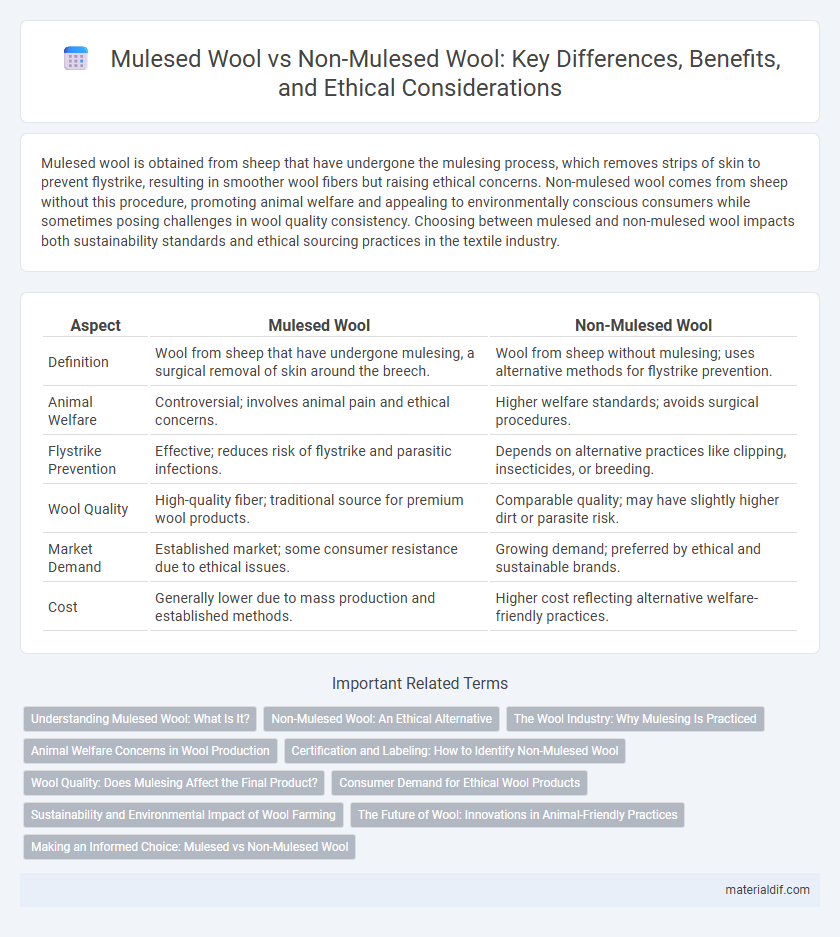Mulesed wool is obtained from sheep that have undergone the mulesing process, which removes strips of skin to prevent flystrike, resulting in smoother wool fibers but raising ethical concerns. Non-mulesed wool comes from sheep without this procedure, promoting animal welfare and appealing to environmentally conscious consumers while sometimes posing challenges in wool quality consistency. Choosing between mulesed and non-mulesed wool impacts both sustainability standards and ethical sourcing practices in the textile industry.
Table of Comparison
| Aspect | Mulesed Wool | Non-Mulesed Wool |
|---|---|---|
| Definition | Wool from sheep that have undergone mulesing, a surgical removal of skin around the breech. | Wool from sheep without mulesing; uses alternative methods for flystrike prevention. |
| Animal Welfare | Controversial; involves animal pain and ethical concerns. | Higher welfare standards; avoids surgical procedures. |
| Flystrike Prevention | Effective; reduces risk of flystrike and parasitic infections. | Depends on alternative practices like clipping, insecticides, or breeding. |
| Wool Quality | High-quality fiber; traditional source for premium wool products. | Comparable quality; may have slightly higher dirt or parasite risk. |
| Market Demand | Established market; some consumer resistance due to ethical issues. | Growing demand; preferred by ethical and sustainable brands. |
| Cost | Generally lower due to mass production and established methods. | Higher cost reflecting alternative welfare-friendly practices. |
Understanding Mulesed Wool: What Is It?
Mulesed wool refers to wool obtained from sheep that have undergone mulesing, a surgical procedure removing strips of skin from around the breech to prevent flystrike. This process eliminates folds of skin where flies can lay eggs, enhancing the sheep's health but raising animal welfare concerns. Non-mulesed wool comes from sheep not subjected to this procedure, often certified by ethical standards promoting sustainable and cruelty-free practices in wool production.
Non-Mulesed Wool: An Ethical Alternative
Non-mulesed wool offers an ethical alternative by eliminating the painful practice of mulesing, which involves removing strips of skin from sheep to prevent flystrike. This wool is sourced from sheep bred and raised with higher welfare standards, ensuring animal comfort and reducing stress. Consumers increasingly prefer non-mulesed wool for its cruelty-free production, supporting sustainable and humane farming practices.
The Wool Industry: Why Mulesing Is Practiced
Mulesing is practiced in the wool industry primarily to prevent flystrike, a serious parasitic condition caused by blowflies laying eggs in wrinkled skin around sheep's breech area, which can lead to severe infections and death. This practice involves removing strips of wool-bearing skin to create smooth, less fly-attractive surfaces, thus reducing the risk of infestation and improving sheep welfare. Despite criticisms, mulesing remains widespread in Australian wool production due to its proven effectiveness in flystrike prevention and maintaining animal health.
Animal Welfare Concerns in Wool Production
Mulesed wool involves removing strips of skin from lambs to prevent flystrike, raising significant animal welfare concerns due to pain and distress caused by the procedure. Non-mulesed wool production avoids this practice, emphasizing ethical treatment by using alternatives like breeding for flystrike resistance and improved farm management. Consumers increasingly prefer non-mulesed wool to support humane practices and promote sustainable animal welfare standards in the textile industry.
Certification and Labeling: How to Identify Non-Mulesed Wool
Non-mulesed wool is commonly certified by organizations such as ZQ Merino, Responsible Wool Standard (RWS), and The Woolmark Company, which ensure animal welfare and ethical practices. Labels indicating non-mulesed wool often feature certifications or claims like "non-mulesed," "mulesing-free," or "ethical wool," providing transparency for consumers. Verifying these certifications through brand websites or third-party databases is essential for confirming the authenticity of non-mulesed wool products.
Wool Quality: Does Mulesing Affect the Final Product?
Mulesing involves removing skin from lambs to prevent flystrike, which can impact wool quality by causing irregular fibers and potential damage. Non-mulesed wool tends to have fewer defects, resulting in a softer, more uniform fiber suitable for high-end textiles. Ultimately, the choice between mulesed and non-mulesed wool affects the final product's consistency, fiber integrity, and market value.
Consumer Demand for Ethical Wool Products
Consumer demand for ethical wool products has significantly increased the popularity of non-mulesed wool, which avoids the painful mulesing process used to prevent flystrike in sheep. Brands sourcing non-mulesed wool emphasize animal welfare, transparency, and certification standards such as Responsible Wool Standard (RWS) to meet conscientious consumer expectations. This shift toward humane practices drives market preference and supports sustainable fashion initiatives.
Sustainability and Environmental Impact of Wool Farming
Non-mulesed wool production prioritizes animal welfare by eliminating the painful removal of skin around sheep's breech, reducing stress and potential infections. Sustainability efforts in non-mulesed wool farming often include responsible land management practices that protect soil health and biodiversity. This approach lessens environmental impact by promoting ethical treatment and minimizing chemical use compared to conventional mulesed wool methods.
The Future of Wool: Innovations in Animal-Friendly Practices
Non-mulesed wool increasingly gains preference due to ethical concerns and evolving animal welfare standards, with innovations like laser technology offering pain-free alternatives to traditional mulesing. Sustainable farming practices and genetic research enhance sheep resilience against flystrike without compromising fiber quality, supporting a shift toward cruelty-free wool production. These advancements position the wool industry to meet consumer demand for transparency and sustainability while preserving the natural properties of high-quality wool.
Making an Informed Choice: Mulesed vs Non-Mulesed Wool
Choosing between mulesed and non-mulesed wool hinges on ethical considerations and product quality. Mulesed wool involves removing skin to prevent flystrike but raises animal welfare concerns, whereas non-mulesed wool prioritizes humane treatment with alternative pest control methods. Understanding the origin and certification of wool helps consumers make informed decisions aligning with their values on sustainability and animal rights.
Mulesed wool vs Non-mulesed wool Infographic

 materialdif.com
materialdif.com